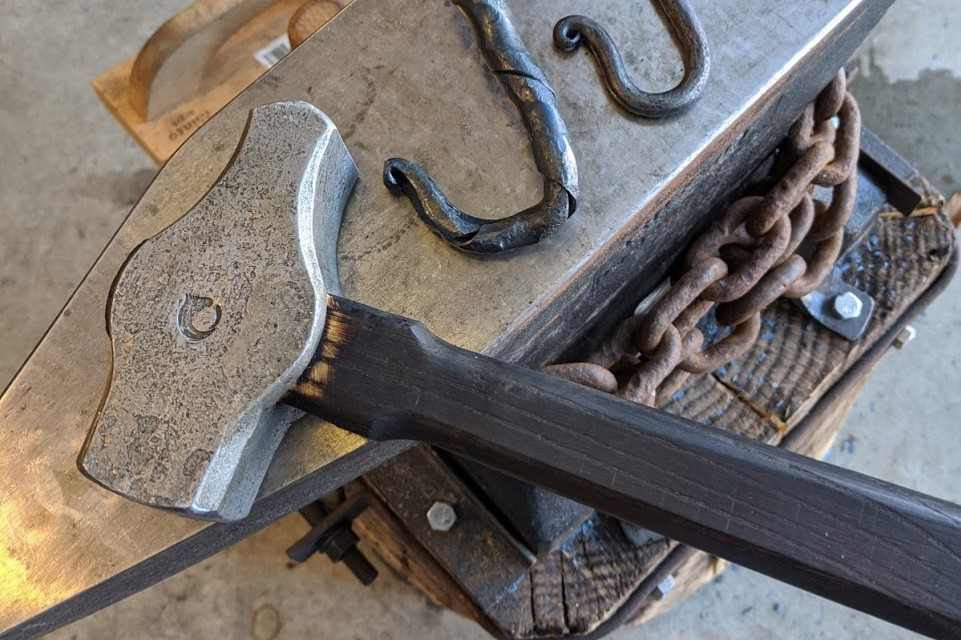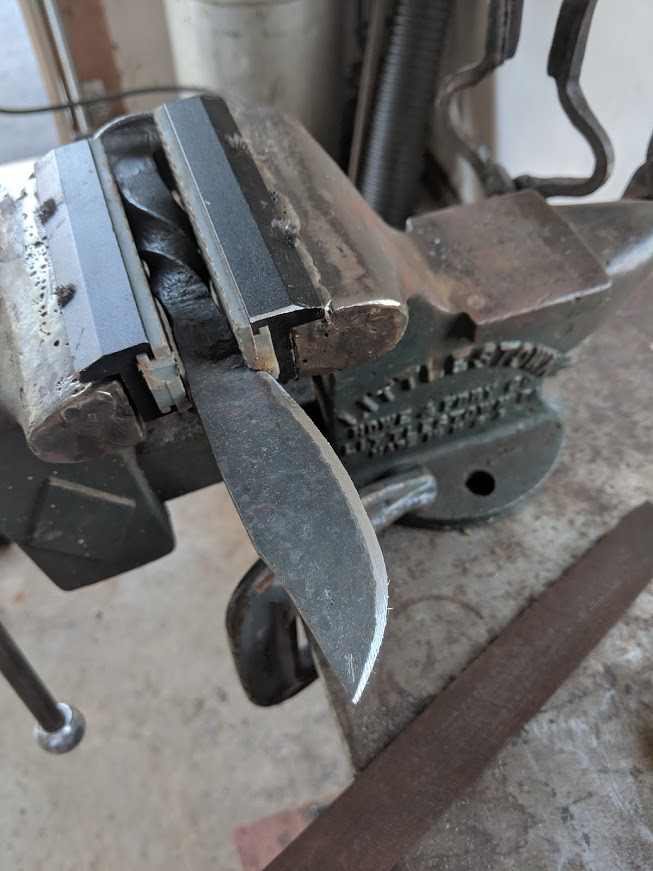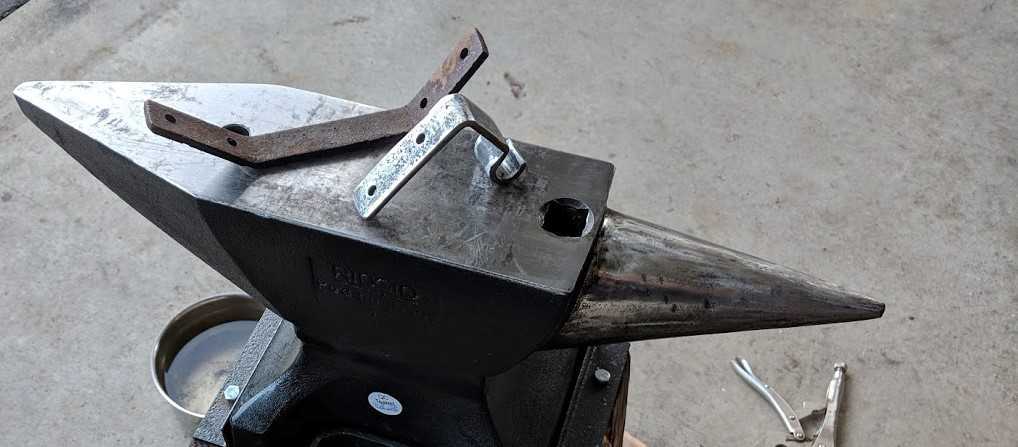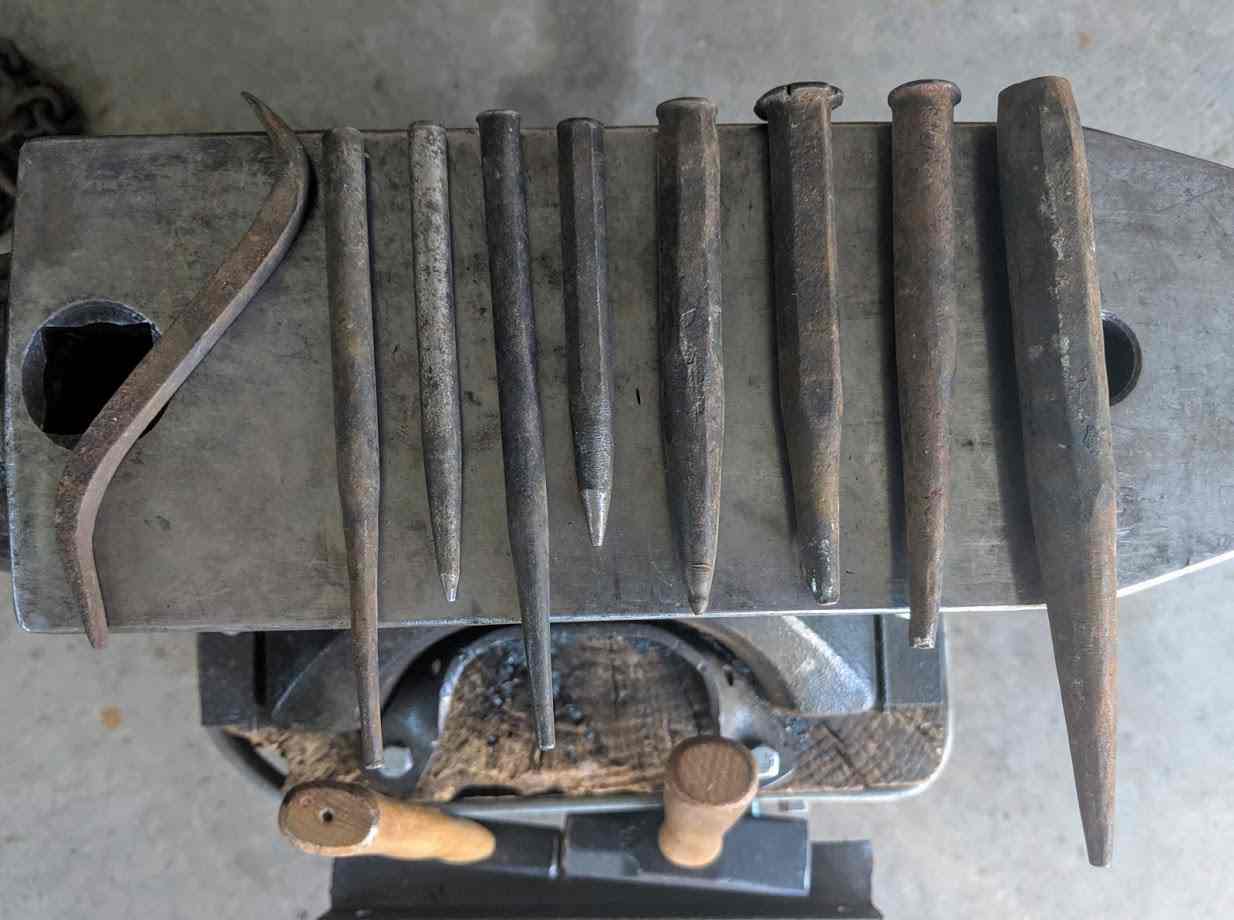As I have continued to learn the art of blacksmithing by reading, watching YouTube videos, and simply doing it, I have noticed that there are 11 hand-tools that most blacksmiths use.
When it comes to Blacksmithing, the saying “There’s a right tool for every job” absolutely applies, but when I started, I didn’t even own an anvil. I had a small forge, a framing hammer, and a pair of vice grips.
This setup worked in the beginning, and over time I acquired new tools and forged others that I either wanted or needed. In fact, the ability to make my own tools is what drew me to the trade. Since then, I saved up for and purchased an anvil, bought a few hammers, and made my own tools
While the tools present in every shop differ, I bet if you look hard enough you will find these.
- HAMMERS
- TONGS
- FILES
- CHISELS & SETS
- HARDY
- PUNCHES
- DRIFTS
- FULLERS
- SWAGES
- BOLSTERS PLATES
- FLATTERS
HAMMERS

In blacksmithing, the hammer hits the steel and the anvil hits it back. The hammer is an extension of your will to move the metal where you want it to go, and using the correct hammer will help you move it more quickly and accurately.
Rounding Hammer
Made popular by blacksmith and YouTube superstar Alec Steele, the rounding hammer is a two-sided (one round – one flat) do-everything hammer.
The flat side is typical of other flat blacksmithing hammers, but the magic happens on the other side. The rounded side!
The rounding hammer can be used to flatten and spread the metal like a multi-directional fuller, and when angled, the edge of the hammer performs like a cross or straight-peen moving the metal in the direction of your choosing.
The radius is larger than that of the Ball-Peen hammer with a gentle arc from center to edge, and while not absolutely necessary for the shop, once mastered the Rounding Hammer just may become your goto implement.
The Rounding Hammer is harder to come by compared to the other hammers in this article. If you are lucky, there is a Blacksmith near you who makes them, otherwise, your best bet may be to purchase one online.
Ball-Peen
Traditionally, most blacksmiths used Ball-Peen hammers as their daily-driver, but nowadays if you watch smiths on YouTube or on the popular television series Forged in Fire, you will notice that Cross-Peen hammers and Rounding Hammers have risen in popularity.
You probably saw a Ball-Peen hammer in your dad’s toolbox when you were a kid. It was small with a black rubber grip and a fiberglass handle, right?
While the head of the hammer was indeed a ball-peen design the similarities stop there.
I can’t speak for all blacksmiths out there, but I’m probably not wrong in saying that most prefer and would recommend a wooden handle. Rubber and hot metal are a recipe for toxic fumes and fire. So unless you want to relive your youth burning tiny green plastic army men, stick with a wooden handle.
Cross-Peen
Speaking of daily drivers, this one is mine.

A Cross-Peen has one side flat and one side forged into the shape of a wedge. The leading edge of the wedge forms a rounded hitting surface about ¼” (and up) in width and as long as the hammer is wide.
The word cross means that the orientation of the hitting edge is perpendicular to the handle. The edge is rounded and polished and is used to directionally fuller or spread metal. It can also be used to deliver very localized hammer blows.
The Cross-Peen is a good all-around hammer, and for the beginner-smith easy to purchase online or in specialty shops.
Straight-Peen
The Straight-Peen hammer is nearly identical to the Cross-Peen save the leading edge is parallel with the handle.
Interestingly, some smiths also use hammers where the peen is forged at a 45-degree angle when compared with the handle.
Long Reach
What sets the Long Reach hammer apart are the extended peens. The hitting surfaces are forge out away from the handle to provide clearance (reach) between the work surface and the handle.
Long Reach hammers are a bit of a specialty item and not used as frequently as Cross-Peen or Ball-Peen hammers. You may be able to source one online or better yet, make one yourself. I hear car axle shafts make pretty good hammers.
Lump
Whenever I see or hear the words “Lump Hammer,” I think of Thor’s hammer. A Lump hammer has a double-faced head and when not fighting off ice-giants 😉 is great for working with chisels and often used by stonemasons.
The Lump hammer is also a bit of a specialty hammer and can be purchased online.
Forging one of these as a mini-replica of Thor’s hammer is definitely on my list of future projects!
Double Faced Sledge

As the name implies, the Double Faced Sledge is a large two-handed hammer often used when you have an assistant striker in the shop and in general, when working larger pieces of metal.
Before the advent of the power hammer and treadle hammer, blacksmithing was done by hand. When forging large material like a hammer, a Double Faced Sledge was used to get the job done.
A Double Faced Sledge is not particularly difficult to find and purchase.
Straight-Peen Sledge
The Straight-Peen Sledge is similar to the Double Faced variant except only one face is flat while the other is a straight-peen.
The Straight-Peen Sledge may be difficult to source for some but can be purchased online.
TONGS
Now that you’ve got a way to hit hot metal, you’ve got to securely hold it in place.
Using the correct pair of tongs is not only a way to maintain a safe working environment (think flying pieces of red-hot steel) but also essential to saving time and effort in the shop.
Tongs come in many shapes and sizes but one thing they all have in common is what they are made of. Because they are frequently heated and cooled, Tongs are generally forged from low to medium carbon steel.
Here are some of my favorite tongs
Wolf’s Jaw
Wolf’s Jaw tongs may be the best first pair of tongs you could own. The jaws of the tongs indeed look like the jaws of a hungry animal with multiple peaks and valleys that are able to grasp different types of metal.
Centaur Forge has a great selection of Wolf’s Jaw tongs.
Bolt
Bolt tongs have a classic and curvy design. They were created to be able to grasp a large bolt while avoiding the hexagonal or square bolt head. Bolt tongs are also helpful when working with railroad spikes.
They can easily be purchased online at any number of online blacksmith shops.
Box Jaw
Box Jaw tongs are king when it comes to working with flat stock. They are very popular when bladesmithing because the tongs literally box in and secure the metal.
Box Jaw tongs are size-specific, meaning the inside width of the tongs corresponds with the outside width of the flat stock.
I personally don’t have a pair of these tongs yet, but making a pair is on my list of future projects. I enjoy making hinges, brackets, and knives so having a pair would be a huge help (especially when working with shorter lengths of steel)!
V-Bit
V-Bit refers to the V-shape design of the jaws. They are perfect for grasping square stock and are available in either the standard tong jaw design or the Bolt jaw design for greater clearance.
In my shop, I have a pair of V-Bit Bolt tongs that I forged out of medium carbon steel, and they have been very useful forging railroad spike knives.
Scrolling
Scrolling Tongs are used not to hold hot metal for hitting but to scroll or bend the metal into a hook or curve. These are great for making decorative pieces like flowers or leaves and can even be used to form small hooks.
Scrolling Tongs are a must if you want to get into the detailed and more creative side of blacksmithing.
FILES
The file is a classic blacksmithing hand-tool! It has been used for ages, it doesn’t require electricity and a good file will last you for years.

Files are used by blacksmiths to bevel, sharpen, clean up ragged edges, and sometimes as material to make an interesting knife (Farrier’s Rasp).
In general, the files used by blacksmiths in North America are the Flat File, the Half-Round File, the Square File, the Triangular File, and the Round File. All these styles of files come in varying lengths and coarseness. Other files are also available, but these seem to be the most common.
Length
Length is an important consideration when choosing a file, and most smiths prefer longer files. They last longer and each stroke of the file is more efficient. A good rule of thumb is to use large coarse files first to take away the bulk of the material. Then, use smaller and less coarse files to do the finish work.
Coarseness
Like sandpaper, files come in varying degrees of coarseness. This can be confusing to the uninitiated, but easily searchable online if you forget. Otherwise, just refer back to this article for a quick reminder.
Most files available in the United States can be purchased in three grades: Bastard-Cut, Second-Cut, and Smooth Cut. The bastard-cut is the coarsest and the smooth-cut is the most refined.
Here is a bit of information on each file.
Flat File
The Flat File is flat on both sides and can file on all sides including the edges. Flat files can be purchased without file marks along the edge. A file without teeth along the edge is a Safe-Edge file.
Half-Round File
Half-Round files are flat on one side and round on the other. They have sharp edges on either side where the round transitions to the flat.
Square File
The Square file has four equal sides with 90-degree corners.
Triangular File
The Triangular file has three equal sides with 60-degree corners.
Round File
The Round file is a long cylindrical file with no edges. They are also known as rat tail file.
Most of the files described above are classified as being a Taper File, meaning the tip is narrower than the base at the handle. This is advantageous when working with more complex surfaces. They give the user more options allowing them to do more without needing to change files.
The opposite of a tapered file is a Blunt File. A blunt file has a constant width with parallel edges. This uniformity can be important if consistency is a requirement.
There are many other shapes and types of files. For example, Swiss Pattern files are also available in seven grades of coarseness and are very effective and popular for finish work. If you see a “00, 0, 1, 2, 3, 4, or 6” stamped near the handle, those numbers are referring to the coarseness of a swiss file.
CHISELS & SETS
Blacksmiths use Chisels and Sets to cut both cold and hot metal. It’s hard to imagine not being able to pick up a 4” grinder with a cut off disk or to walk over to the porta-band saw and make a quick cut, but in the past, cutting was accomplished one blow at a time.
Chisels
Chisels come in two varieties, one meant to cut hot metal and the other cold. Cold chisels need to take the abuse of hitting cold-hard steel so they are short and stout.
Hot chisels are longer and thinner. This is both because it is easier to work with hot metal, but also because of radiant heat. A longer chisel allows the hand holding the chisel to be farther away from the anvil keeping that hand cooler.
TIP: It’s not uncommon for a smith to wear an appropriate heat-protective glove when using a hot cut chisel.
Sets
Sets are also used to cut hot and cold steel. In essence, they are chisels with handles. They are also similar in the fact that cold sets are short and stout while hot sets are long and the cutting edge comes to a narrower point.
The handles can be made out of wood or using metal rods, and both handles have their advantages and have a place in the shop.
Some blacksmiths report that wood handled sets are more comfortable than metal-rod handles and others prefer wood for handwork and metal when using a power hammer. In the end, both work and it’s up to you to decide what you would like to use.
HARDY
A Hardy (or Hardie) is a heavy-duty chisel with a square shank that fits into a square hole in an anvil. Not coincidentally, that hole on the anvil is called a Hardy Hole.

A shoulder above the shank holds the hardy securely on top of the anvil’s face. The chisel is used to cut off hot steel, and can also be used to mark cold steel for future purposes.
Other tools are also used in the hardy hole provided they too have a square shank that matches the dimensions of the hardy hole in the anvil. These include Top and Bottom Fullers and Swages.
PUNCHES
Punches come in a variety of shapes to include round, octagonal, or even square, but they all accomplish the same thing. The purpose of a punch is to create a hole while removing a minimum amount of material.

A punch is hammered into hot material from either side of a piece until a hole is formed and swelled to match the size and shape of the punch.
When done correctly, only a small slug is left (and discarded) after the hole is formed.
Punches are long to keep your hand away from the hot metal. They can be held with the hand and some have handles that are convenient if working with a power hammer or treadle hammer.
DRIFTS
Drifts are the shorter stronger little brother to punches. They also can be of any shape desired and are hammered into a hole to attain the desired size and shape.
If you have ever watched a blacksmith make a hammer, then you have probably seen punches and drifts in action. First, they punch an eye, then they use a drift to size the hole for the handle. Often, they will use a pinch of coal dust or special drifting-grease to help prevent the drift from getting stuck in the opening.
A more severe example of this is when a smith forges the opening or an ax. A drift can be essential to attain the desired size and shape.
FULLERS
Fullers are generally made in sets. The top and bottom have rounded edges and is most commonly used to symmetrically set down shoulders prior to forging tenons. Another historic use of a fuller set was to forge a fuller groove down the length of a sword.
There are several different types of fuller-sets to include:
- Anvil Hardy Hole bottom with handled top set.
- Spring fuller with top and bottom attached with U-shaped flat bar stock.
- Guillotine Fullers like a Smithin Magician secured in the hardy hole.
SWAGES
Most commonly, swages have a semicircular design and are used as a set where the top and bottom set form a complete circle. Together a swage set is used to forge round sections.
Swage sets include a top and bottom set which uses the hardy hold as well as a Spring Swage which may or may not use the hardy hole. A spring swage secured in the hardy hole is perfect for the blacksmith working alone.
An alternative to a swage set and the fuller set is to use a tool like the Smithin Magician which has removable dies. They allow a blacksmith to cut, fuller, and create tenons all with one tool.
BOLSTERS PLATES
Bolster Plates are most commonly used to head nails and rivets, though other applications do exist like countersunk bolt heads.
As the name implies they are formed from a steel plate and have the desire holes either punched and drifted or drilled to the appropriate size. They have a flat bottom and used on top of the anvil which allows the piece being headed to protrude through the bolster plate and through either the hardy or the pritchel hole.
TIP: A Pritchel is a type of punch used by farriers to make nail holes in horseshoes.
FLATTERS
The Flatter is a finishing tool. It looks similar to a hammer and has a large flat face and a handle. Using another hammer to hit the flatter, it imparts a smooth flat finish to the work surface.
It is often used at the anvil to flatten and smooth to reduce finishing time later with a file or grinder.
Conclusion
So there you go, 11 Hand-Tools that blacksmiths use.
Hopefully, this list was of some use and provided a little more information than you knew before. As I continue in the trade, I will likely be back here adding more nuanced information here and there.
As always, the best way to understand any tool is to use it!


